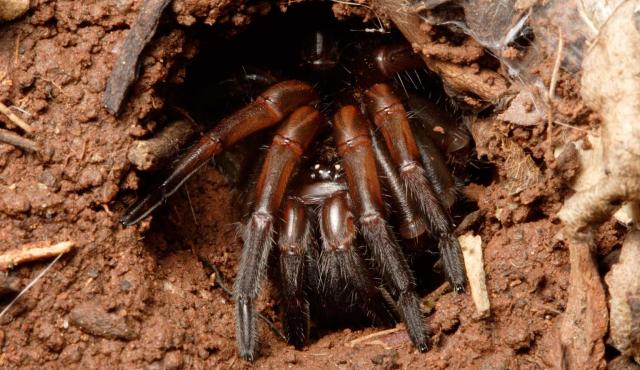A range of teacher professional learning programs will be developed to accompany the Biodiversity of the Western Volcanic Plains online outreach...

Trapdoor Spider
Stanwellia sp.
Feeds at night, catching its prey by waiting for an insect to ‘trip’ the silken threads outside the burrow. It then rushes out to grab its prey. Despite its common name, the entrance of this spider's burrow does not have a 'trap-door'. Trap-door spiders can live up to 20 years.
| Details | Description |
| Type | Invertebrate |
| Group | Arachnid - Spider |
| Identifying Characteristics | |
| Distinctive Markings | A large spider with a dark, mottled rib-like pattern on the upper surface of its abdomen. |
| Diet | Carnivore. Eats insects. |
| Habitat | A ground-dwelling spider that digs silk-lined burrows up to 40 cm deep in soft earth. |
| Native Status | Native to Australia |
| Bites/Sting | Due to the size of its fangs, the Trapdoor spider can inflict a painful wound, but the venom is not known to cause medical problems. |
| Taxonomy | |
| Phylum | Arthropoda |
| Class | Arachnida |
| Order | Araneae |
| Family | Nemesiidae |
| Genus | Stanwellia |
| Species | sp. |

Distribution maps indicate current and historic locations where species have been sighted.
Source: Atlas of Living Australia
| Conservation Status | |
| DEPI Advisory List | Not listed |
| FFG Act | Not listed |
| EPBC Act | Not listed |
The conservation status of species is listed within Victoria and Australia.
The Department of Environment and Primary Industry (DEPI) Advisory List consists of non-statutory advisory lists of rare or threatened flora and fauna within Victoria.
The Flora and Fauna Guarantee Act 1988 (FFG Act) lists threatened species in Victoria. Under the Act, an Action Statement is produced for each listed species.
The Environment Protection and Biodiversity Conservation Act 1999 (EPBC Act) is the Australian Government’s key piece of environmental legislation, listing nationally threatened native species and ecological communities.



